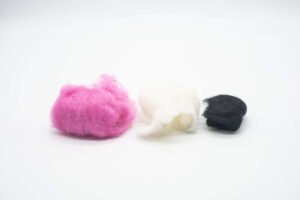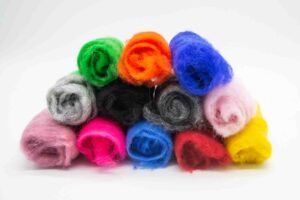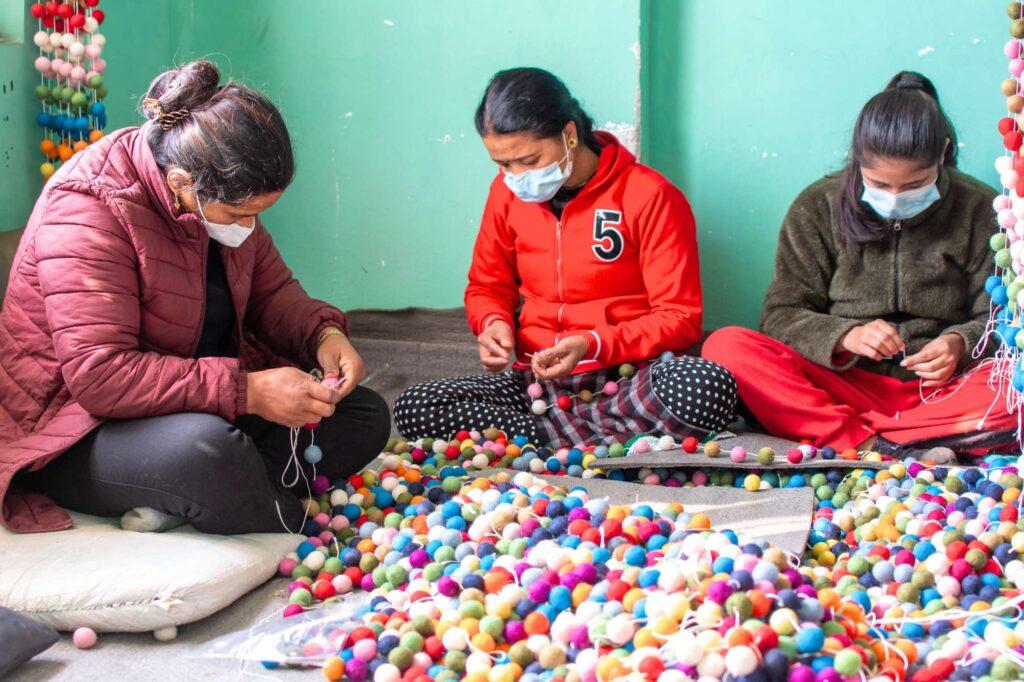If you are just starting to felt then it can be intimidating to choose the right wool at the beginner phase. We all had our share of trouble in finding the perfect wool. Different varieties of wools are available nowadays having different properties and ranging from the different price range. We encounter different wool with different names, textures, and colors.
In this article, we are talking about wools only. We will know about different stages of wool we can find, what to look for when choosing wool, types of wool to choose for the finishing we are looking and different breeds of wool.
Stages of Wool

Generally, the wools are available in four processing stages. They are dirty raw fleece, cleaned raw fleece, tops or roving, and batts.
Raw Fleece
Wool obtained straight from the sheep or any animals which are untouched is a raw fleece. The fleece is full of dirt and Lanolin They are not suitable for felting.
Cleaned Raw Fleece
After the wool is sheared, it is cleaned using water and mild detergent to remove dirt and the grease called Lanolin from the wool. They are later combed or carded for further stages. This can be used in felting to give texture and effects to your projects as the fibers are mostly curly.
Batts
Batts are simply shorter fiber in messed-up order. The fiber is all facing in different directions and available in chunky sheets. They come in a rolled sheet where you can tease off your desired amount of wool. This stage of wool is great for any felting project as the fibers are not aligned parallel to each other. They bond together easily when felted.
Tops or Roving
The longer fibers resulting from combing, carding, and sorting are called tops. They are made in a form that is ready for spinning into yarn. Whereas wools roving is the shorter version of tops and is twisted slightly for holding the fibers together. The fiber is aligned to each other making it easy to form a yarn. Both the fibers are suitable for wet felting and needle felting as well.
What To Look For When Felting?
Not every kind of wool felts. We need to consider different aspects when choosing the wool-like fiber content, how the wool is treated, the amount of crimp in the wool, and the nature of wool.
Nature Of Wool
We can find different natured wools. They can be natural and synthetic. The natural fibers are easy to felt but the synthetic ones may be hard to felt. So as a beginner we recommend you to use 100% natural wool. They are easily available and you can felt them with great ease. Synthetic fibers are either laced with other types of fabric like silk, nylon. These types of wool are best for spinning rather than felting.
Treatment
Sometimes the wool is super washed and treated to prevent any shrinkage to the wool. This type of wool serves a different purpose and is not suitable for felting. The dyes and the bleach also affect the wool’s ability to bond. You do need cleaned fleece but be sure that they are cleaned without using any harsh chemicals.
Crimp
The wavy texture you see on the wool is called crimp. Wools with more crimp helps the wool felt more easily. The wool matt is better compared to silky strands. So go for wool with more crimp rather than going for silky ones.
Based On The Finishing
Different types of wool give different finishing. Like you might be looking for a smooth and neat finish, or more longer fur finish, shiny finish and curly finish. You can achieve different finishing using the same breed of wool, it just depends on the technique that you use. We can take Merino wool for example. This breed of wool is the most commonly used wool and is versatile.
A different technique provides a different result. Some breeds of wool are best for a particular type of finish. For example, Wensleydale sheep produce beautiful curly fleece, which is great for adding surface texture. So you can explore among the available wools and see which matches your preferences.
Breeds Of Wool

We can find a different breed of wool. Wool is not only obtained from sheep but can be obtained from other furry animals like little rabbits, camels, and goats. Here I have listed the best wool that can be used for felting.
Merino Wool
Merino wool is the most commonly used wool. The wool is sheered from merino sheep which was originated in Spain. At present, the wool is mostly sourced from Australia, South Africa, and New Zealand.
This type of wool is very soft, light, and silky. Its softness is the most notable and favorite aspect of this wool. It is so light that it can easily fly away with a whiff of air. This type of fiber has a length of about 7.5- 10 cm is about 3-4 inches. The fiber is laid in the same direction making it a bit hard for felting. The felting takes more time than usual. Despite that difficulty, it is the best out there. Many felting kits for a beginner come with merino wool.
Shetland Wool
Shetland wool is obtained from the Shetland Sheep habituated in the Shetland Isles of Scotland. They are quite bulkier compare to Merino wool. The staple length of this type of wool is 2 to 4 1/2 inches long. The wool is soft and silky to touch. The wool has a good amount of crimp. They come in a range of shades formed naturally like white, brown, gray, and black. Although the wool is finer, they are great for wet felting.
Corriedale Wool
Corriedale wool is sheered from the sheep which are crossbreds of Merino and Lincoln. It was developed in Australia and New Zealand. This type of sheep is used for dual purposes, for meat and wool.
The wool is less fine compared to the Merino and Shetlands. The wool lengths are between 3-5 inches with a width of around 20-30 microns. The wool has a well-defined crimp making it one of the best for wet felting. Because the fiber is a bit smoother, the needle has a hard time grabbing onto the fiber when the needle is felting making it not so suitable.
Lambswool
As the name suggests, lambswool is obtained from the lamb of sheep. This type of wool is also called Virgin wool as it is obtained from the first shearing of the young sheep. When the lamb is about 7 months their wool is sheared.
This type of wool is very soft, fine, and light. The softness of the wool varies depending on the breed of sheep. The staple length of fiber is about 50 millimeters or 2 inches or shorter. The fiber strands have heavy scaling making it easy to wet felt. This type of wool is best for making clothes as it is less likely to cause skin irritation compared to other wool.
Romney Wool
Romney wool is sheared from the large sheep called Romney which is habituated in the marshy coastal area of Southern England. The wool is stronger compared to other types of wool.
The wool is heavy, semi-lustrous, and coarse. Due to their high yielding properties, they are used for making commercial products, The fiber lengths are from 5 – 8 inches with a width greater than 30 microns. The wool has a high well-defined crimp making it easier for wet felt strongly. The products made from this type of wool are very durable but soft textured. So they are mostly used for making carpets.
Bluefaced Leicester Wool
Bluefaced Leicester wool is obtained from the same-named sheep that originated in the country of Northumberland, England. This type of wool is very popular.
The fiber of the wool is curly, fine, soft, and lustrous. As the fiber does not have scales it gives off a lustrous appearance. The fiber has about 6 inches in length and width of 24-28 microns. This type of fiber felts slowly but the results that you get is worth the wait. You get beautiful defined results with soft texture when wet felted. It is available in three natural colors.
We hope this article helped you in choosing the right wool for felting. As you get to know that felting is a wide field with great options, and to express your creativity. You can experiment with a different type of wool with different properties and find the right one for you. It sure can be mind-boggling but as you keep on exploring, you will start getting the idea of choosing the right materials for felting.
Happy Felting!
For All Kinds of ethically handmade felt products visit www.woollyfelt.com .

